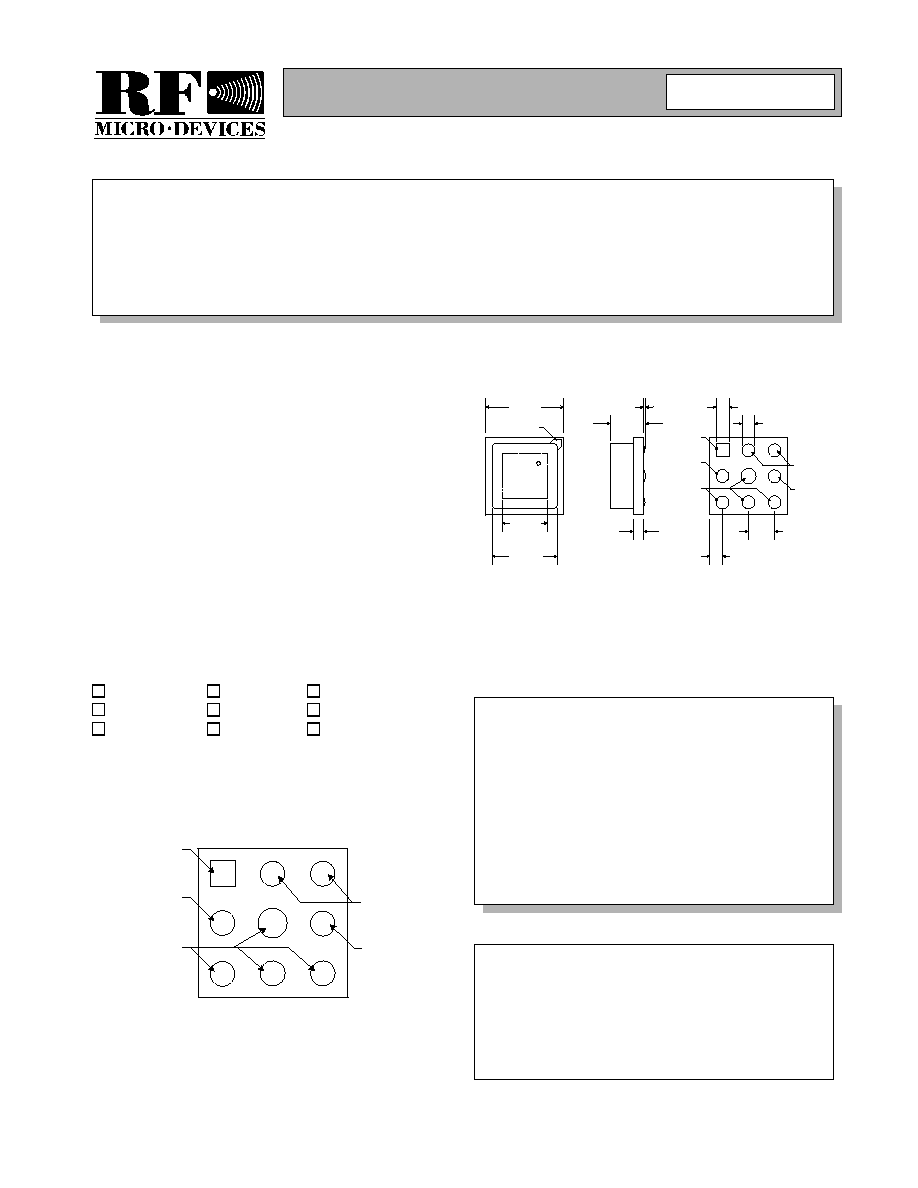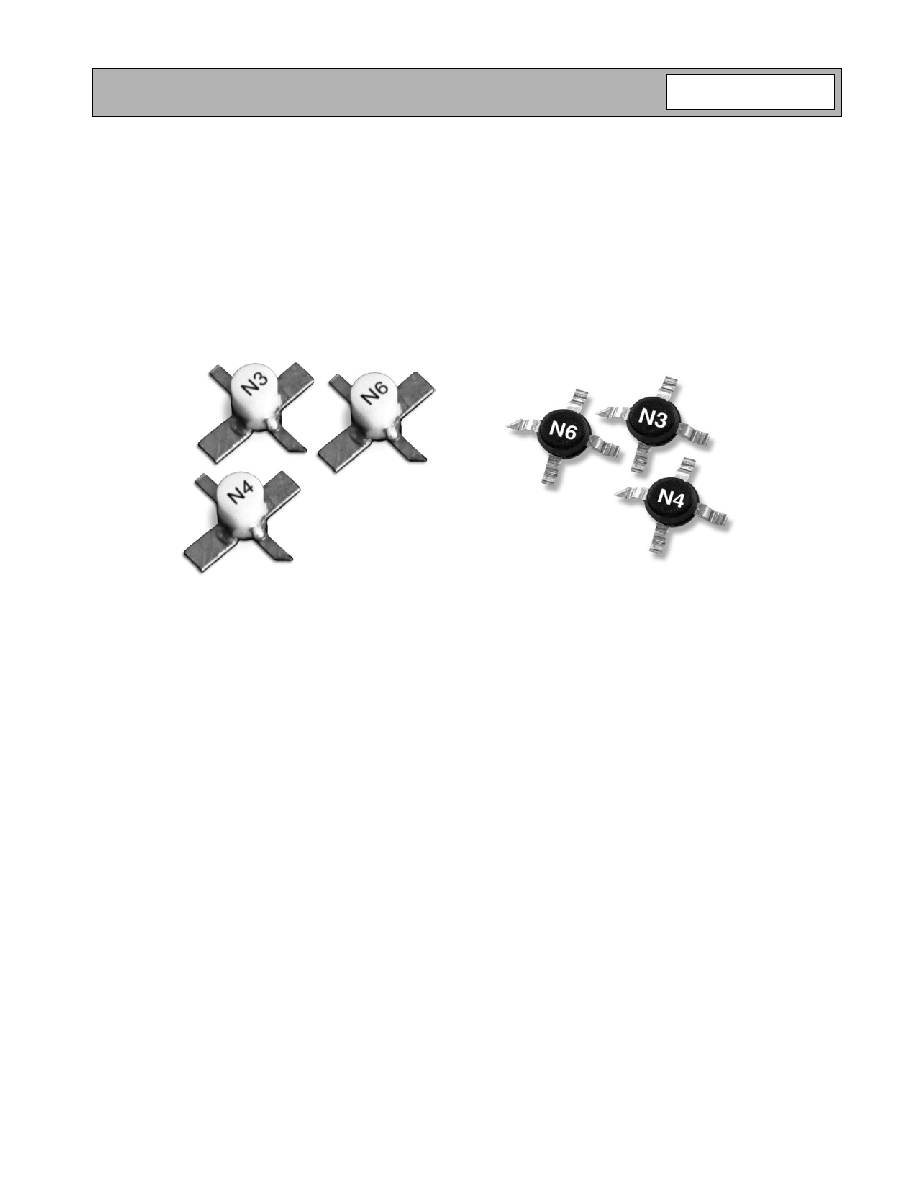
4-41
Product Description
Ordering Information
Typical Applications
Features
Functional Block Diagram
RF Micro Devices, Inc.
7628 Thorndike Road
Greensboro, NC 27409, USA
Tel (336) 664 1233
Fax (336) 664 0454
http://www.rfmd.com
Optimum Technology MatchingÆ Applied
Si BJT
GaAs MESFET
GaAs HBT
Si Bi-CMOS
SiGe HBT
Si CMOS
InGaP/HBT
GaN HEMT
SiGe Bi-CMOS
Pin 1
Indicator
RF OUT
Ground
RF IN
Ground
1
9
6
5
7
8
4
3
2
NBB-402
CASCADABLE BROADBAND
GaAs MMIC AMPLIFIER DC TO 8GHz
∑ Narrow and Broadband Commercial and
Military Radio Designs
∑ Linear and Saturated Amplifiers
∑ Gain Stage or Driver Amplifiers for
MWRadio/Optical Designs (PTP/PMP/
LMDS/UNII/VSAT/WLAN/Cellular/DWDM)
The NBB-402 cascadable broadband InGaP/GaAs MMIC
amplifier is a low-cost, high-performance solution for gen-
eral purpose RF and microwave amplification needs. This
50
gain block is based on a reliable HBT proprietary
MMIC design, providing unsurpassed performance for
small-signal applications. Designed with an external bias
resistor, the NBB-402 provides flexibility and stability. The
NBB-402 is packaged in a low-cost, surface-mount
ceramic package, providing ease of assembly for high-
volume tape-and-reel requirements.
∑ Reliable, Low-Cost HBT Design
∑ 15.0dB Gain, +15.8dBm P1dB@2GHz
∑ High P1dB of +15.4dBm@6.0GHz
∑ Single Power Supply Operation
∑ 50
I/O Matched for High Freq. Use
NBB-402
Cascadable Broadband GaAs MMIC Amplifier DC to
8GHz
NBB-402-T1 or -T3Tape & Reel, 1000 or 3000 Pieces (respectively)
NBB-402-E
Fully Assembled Evaluation Board
NBB-X-K1
Extended Frequency InGaP Amp Designer's Tool Kit
0
Rev A4 031110
Notes:
1. Solder pads are coplanar to within ±0.025 mm.
2. Lid will be centered relative to frontside metallization with a tolerance of ±0.13 mm.
3. Mark to include two characters and dot to reference pin 1.
N4
2.39 min
2.59 max
Lid ID
1.70 min
1.91 max
2.94 min
3.28 max
Pin 1
Indicator
1.00 min
1.50 max
0.025 min
0.125 max
0.38 nom
Pin 1
Indicator
RF OUT
0.98 min
1.02 max
Ground
0.50 nom
0.50 nom
All Dimensions in Millimeters
0.37 min
0.63 max
RF IN
Ground
Package Style: MPGA, Bowtie, 3x3, Ceramic

4-42
NBB-402
Rev A4 031110
Absolute Maximum Ratings
Parameter
Rating
Unit
RF Input Power
+20
dBm
Power Dissipation
300
mW
Device Current
70
mA
Channel Temperature
200
∞C
Operating Temperature
-45 to +85
∞C
Storage Temperature
-65 to +150
∞C
Exceeding any one or a combination of these limits may cause permanent damage.
Parameter
Specification
Unit
Condition
Min.
Typ.
Max.
Overall
V
D
=+3.9V, I
CC
=47mA, Z
0
=50
, T
A
=+25∞C
Small Signal Power Gain, S21
15.0
17.1
dB
f=0.1GHz to 1.0GHz
15.8
dB
f=1.0GHz to 4.0GHz
14.3
dB
f=4.0GHz to 6.0GHz
12.0
12.5
dB
f=6.0GHz to 8.0GHz
Gain Flatness, GF
±0.8
dB
f=0.1GHz to 5.0GHz
Input and Output VSWR
1.45:1
f=0.1GHz to 4.0GHz
1.30:1
f=4.0GHz to 8.0GHz
1.80:1
f=8.0GHz to 10.0GHz
Bandwidth, BW
6.3
GHz
BW3 (3dB)
Output Power @
-1dB Compression, P1dB
15.8
dBm
f=2.0GHz
15.4
dBm
f=6.0GHz
15.5
dBm
f=8.0GHz
Noise Figure, NF
4.3
dB
f=3.0GHz
Third Order Intercept, IP3
+26.0
dBm
f=2.0GHz
Reverse Isolation, S12
-17.5
dB
f=0.1GHz to 12.0GHz
Device Voltage, V
D
3.6
3.9
4.2
V
Gain Temperature Coefficient,
G
T
/
T
-0.0015
dB/∞C
MTTF versus Temperature
@ I
CC
=50mA
Case Temperature
85
∞C
Junction Temperature
120.9
∞C
MTTF
>1,000,000
hours
Thermal Resistance
JC
196
∞C/W
J
T
T
CASE
≠
V
D
I
CC
---------------------------
JC
∞C Watt
/
(
)
=
Caution! ESD sensitive device.
RF Micro Devices believes the furnished information is correct and accurate
at the time of this printing. However, RF Micro Devices reserves the right to
make changes to its products without notice. RF Micro Devices does not
assume responsibility for the use of the described product(s).

4-43
NBB-402
Rev A4 031110
Pin
Function
Description
Interface Schematic
1
GND
Ground connection. For best performance, keep traces physically short
and connect immediately to ground plane.
2
GND
Same as pin 1.
3
GND
Same as pin 1.
4
RF IN
RF input pin. This pin is NOT internally DC blocked. A DC blocking
capacitor, suitable for the frequency of operation, should be used in
most applications. DC coupling of the input is not allowed, because this
will override the internal feedback loop and cause temperature instabil-
ity.
5
GND
Same as pin 1.
6
GND
Same as pin 1.
7
GND
Same as pin 1.
8
RF OUT
RF output and bias pin. Biasing is accomplished with an external series
resistor and choke inductor to V
CC
. The resistor is selected to set the
DC current into this pin to a desired level. The resistor value is deter-
mined by the following equation:
Care should also be taken in the resistor selection to ensure that the
current into the part never exceeds maximum datasheet operating cur-
rent over the planned operating temperature. This means that a resistor
between the supply and this pin is always required, even if a supply
near 5.0V is available, to provide DC feedback to prevent thermal run-
away. Alternatively, a constant current supply circuit may be imple-
mented. Because DC is present on this pin, a DC blocking capacitor,
suitable for the frequency of operation, should be used in most applica-
tions. The supply side of the bias network should also be well
bypassed.
9
GND
Same as pin 1.
R
V
CC
V
DEVICE
≠
(
)
I
CC
-------------------------------------------
=
RF OUT
RF IN

4-44
NBB-402
Rev A4 031110
Typical Bias Configuration
Application notes related to biasing circuit, device footprint, and thermal considerations are available on request.
Application Notes
Die Attach
The die attach process mechanically attaches the die to the circuit substrate. In addition, it electrically connects the
ground to the trace on which the chip is mounted, and establishes the thermal path by which heat can leave the chip.
Wire Bonding
Electrical connections to the chip are made through wire bonds. Either wedge or ball bonding methods are acceptable
practices for wire bonding.
Assembly Procedure
Epoxy or eutectic die attach are both acceptable attachment methods. Top and bottom metallization are gold. Conductive
silver-filled epoxies are recommended. This procedure involves the use of epoxy to form a joint between the backside
gold of the chip and the metallized area of the substrate. A 150∞C cure for 1 hour is necessary. Recommended epoxy is
Ablebond 84-1LMI from Ablestik.
Bonding Temperature (Wedge or Ball)
It is recommended that the heater block temperature be set to 160∞C±10∞C.
Recommended Bias Resistor Values
Supply Voltage, V
CC
(V)
5
8
10
12
15
20
Bias Resistor, R
CC
(
)
22
81
122
162
222
322
C block
4
8
1,2,3
C block
In
Out
L choke
(optional)
R
CC
V
CC
V
D
= 3.9 V
V
DEVICE
5,6,7,9

4-45
NBB-402
Rev A4 031110
Extended Frequency InGaP Amplifier Designer's Tool Kit
NBB-X-K1
This tool kit was created to assist in the design-in of the RFMD NBB- and NLB-series InGap HBT gain block amplifiers.
Each tool kit contains the following.
∑ 5 each NBB-300, NBB-310 and NBB-400 Ceramic Micro-X Amplifiers
∑ 5 each NLB-300, NLB-310 and NLB-400 Plastic Micro-X Amplifiers
∑ 2 Broadband Evaluation Boards and High Frequency SMA Connectors
∑ Broadband Bias Instructions and Specification Summary Index for ease of operation




